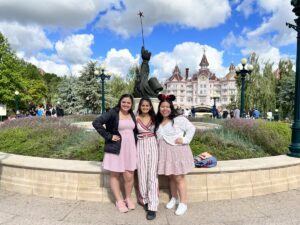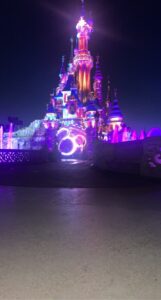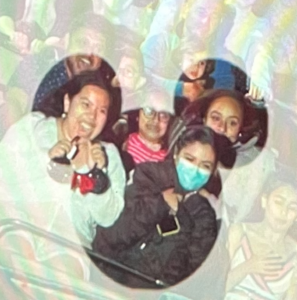Last Sunday, my roommate and I woke up bright and early to head to Disneyland Paris and enjoy the day at the happiest place on earth! Once it was confirmed that I would be traveling to Paris, I made sure to pack my Minnie Mouse ears– a souvenir that I have held onto for the last ten years.

Once we got there, we got a map and created a list of attractions and rides that we wanted to make sure to cross off of our list. We started the day off at Frontierland where our first attraction was a spooky tour of the Phantom Manor which was the perfect ride to begin with– nice and slow. However, once we headed over to Discoveryland, I began hearing loud screams coming from the Star Wars Hyperspace Mountain. I should probably note that I’m not a big fan of rollercoasters, in fact, I try to stay away from them. I knew that the main park was meant to be family-friendly, so I was anticipating the classic attractions such as the teacups.

After some internal conflict, I decided to carpe diem and go for it– I was in Disneyland Paris after all. Once we were close to the front, we could see people turning back after being so close to facing their fear. We could also see the look of shock in people stumbling off of the ride, with their hair in disarray after facing such speed. During the ride, I held onto the restraint as if my life depended on it– which felt like the actual task. My head and body were shaken back and forth, hitting the sides of the seat. Once the two minutes of darkness were over, I struggled to get out of my seat and felt very dizzy. After surviving the ride, I had a small headache for the next 30 minutes.

This experience made me wonder if rollercoasters and head discomfort/injuries could be associated. I found that evidence suggests that motion during a roller coaster ride does not meet the threshold of a traumatic brain injury (TBI) (Evans, 2020). While there are case studies that present individuals who have suffered brain injuries after a ride, it cannot be solely attributed to the ride itself, but the condition of the rider and if they have prior known – or unknown- brain/neck injuries. Learning raised concerns about the insufficient warnings for the “thrill” rides, even at Disney. Should theme parks be more explicit in their warnings or should riders be the judge of their participation in rides?
Evans, V. (2020). Newton’s laws, G-forces and the impact on the brain. Australasian Journal of Neuroscience , 30(1), 24–29. https://search.informit.org/doi/10.3316/informit.273755632351926
